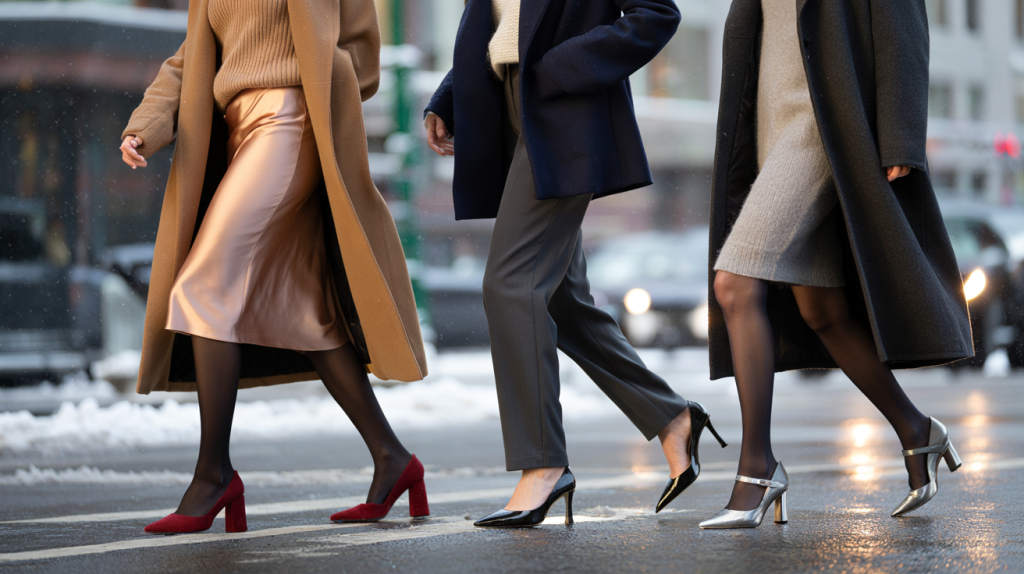Yes, sexy heels can thrive in winter. The trick is smart fabrics, grippy soles, and outfits that lock in warmth while keeping that long-line silhouette that heels do best.
Between icy sidewalks and overheated rooms, the season tests every outfit. The goal is simple: stay warm outdoors, feel confident inside, and move safely. Closed-toe pumps, block-heel boots, slingbacks with tights, even Mary Janes can look sleek in January with the right layers and textures.
Sexy heels in winter outfits: what really works now
Materials change everything. Suede and patent leather keep structure and look luxe under coats. A thin rubber outsole or added half-sole increases grip without changing the shoe shape. Closed toes keep warmth, while slingbacks pair well with opaque tights for a graphic finish.
Heel shape matters on wet pavements. Block heels and platforms add stability, kitten heels keep the leg line with less pressure, and stilettos save the moment indoors. Dark neutrals lengthen the silhouette, but a red pump or metallic Mary Jane wakes up a navy coat instantly.
Winter outfit formulas that make heels easy
Building from thermal tights and a long coat creates a protective shell. Inside, silky layers let heels shine without bulk. Below, quick formulas that work on repeat.
- Camel wrap coat + ribbed turtleneck + midi slip skirt + suede block-heel pumps
- Wool blazer + fine merino knit + tailored trousers + patent slingback heels
- Long puffer + cashmere dress + fleece-lined tights + platform Mary Janes
- Maxi skirt + fitted cardigan + knee-high heeled boots with treaded sole
- Denim with dark wash + oversized coat + pointed kitten heels
- Monochrome knit set + structured leather jacket + croc-embossed pumps
If commuting gets slushy, commute in lug-sole ankle boots, then switch to stilettos at the office. A foldable shoe bag and a slim sock pair in the tote keep everything discreet.
Comfort, grip and health: safer heels in cold weather
Anti-slip steps cut risk fast. Add adhesive rubber half-soles, choose 40–100 denier tights for warmth and durability, and line insoles with shearling or foam for shock absorption. On black ice days, pick a 4–6 cm heel or a stable block heel for the walk, then change indoors.
The numbers support caution. An analysis of U.S. emergency department data reported 123,355 high heel-related injuries between 2002 and 2012, with annual cases roughly doubling over that period (American Journal of Emergency Medicine, 2015). Most involved ankles and feet. Better grip and height strategy reduce exposure, especially on commutes.
Small fit tweaks help circulation. Leave a thumb’s width at the toe, use gel pads to prevent sliding, and angle the strap of a Mary Jane slightly higher on the instep to stabilize the arch. Heels look sharper when the wearer moves without tension, and that starts with support.
Sustainable winter heels: smarter picks and care that last
Choice of materials and care routine make a measurable difference. The fashion sector accounts for an estimated 8–10 percent of global carbon emissions, according to the United Nations Environment Programme in 2019. Extending the life of shoes and clothes pays off.
WRAP has reported that extending the active life of garments by around nine months can reduce carbon, water and waste footprints by 20–30 percent (WRAP, “Valuing Our Clothes”, 2012). For heels, that means protective sprays before the first wear, rotating pairs to let leather rest, and replacing heel tips early instead of waiting for damage.
Sourcing matters too. Look for certified leather, recycled linings, and resolable constructions. A classic black pump or knee-high boot with a resolable sole stays in rotation for years. That’s cost per wear, and it is definitly style per winter.
To pull it all together, check the forecast first. Pick the commute-friendly sole and heel height, then lock in warmth with tights and a long coat. The sexy part is the clean line and the confident step, and that comes from planning the switch from sidewalk to indoor shine.
